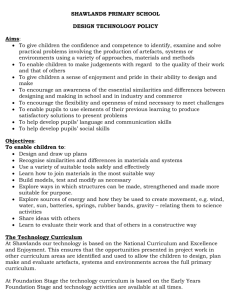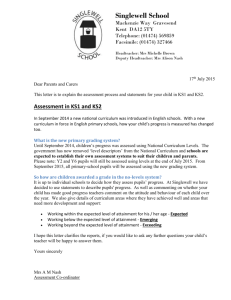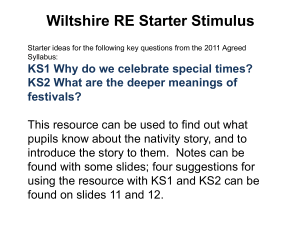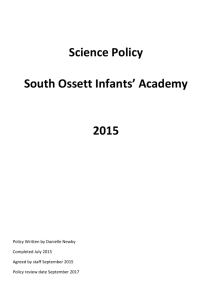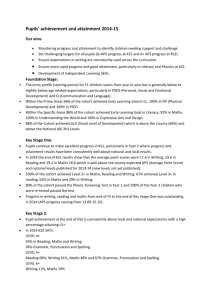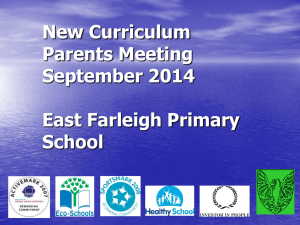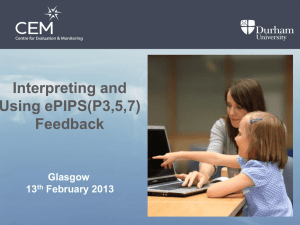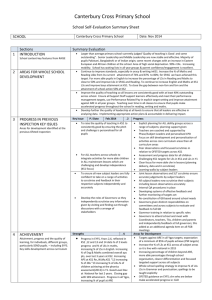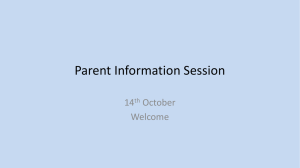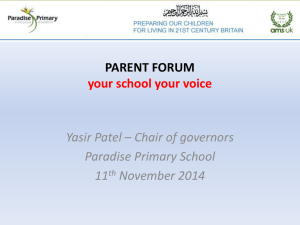New_Curriculum_2014 (Size:1.55MB)
advertisement
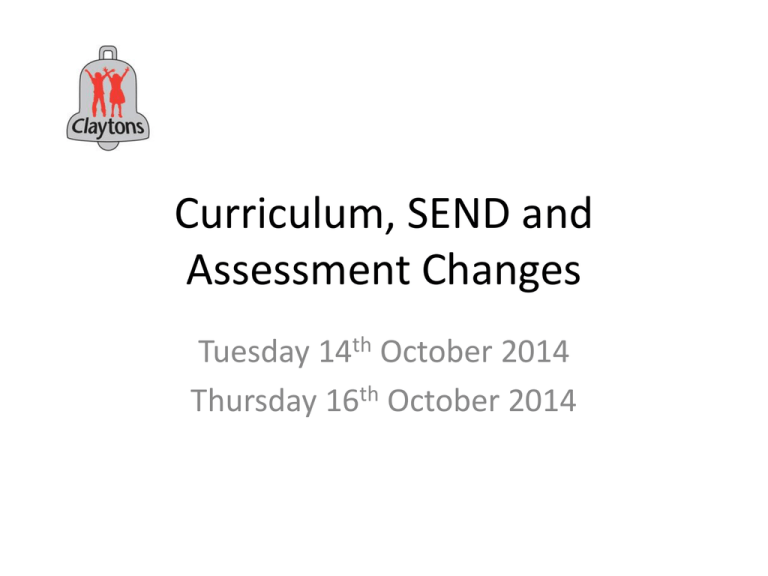
Curriculum, SEND and Assessment Changes Tuesday 14th October 2014 Thursday 16th October 2014 Purpose of the meeting To discuss the Children and Families Act 2014 and to explain the impact of this act on children with special educational needs. To explain why we have a new National Curriculum and how the new National Curriculum is different from the old National Curriculum. To explain the new assessment procedure at Claytons. Children & Families Bill 2014 The Children & Families Bill 2014 has introduced far reaching changes. Part 3 of the legislation relates to special educational needs and disabilities. The 7 Key Changes 1. Involvement of children, young people and parents at the heart of the legislation 2. More coordinated assessment process; new 0-25 Education, Health and Care Plan 3. LA, health and care services to commission services jointly re SEN & disabilities 4. LAs to publish a clear, transparent local offer of services for all CYP (Children and Young People) with SEND www.bucksfamilyinfo.org The 7 Key Changes 5. New statutory protections for young people aged 1625; stronger focus on preparing for adulthood 6. Offer of a personal budget for families and young people with a Plan, extending choice and control over their support 7. All SEN duties to apply equally to all schools, inc. Academies and Free Schools What does this mean for us? The categories School Action and School Action Plus have been replaced by a new category Additional SEN Support. The school is in the process of reviewing the SEND register to reflect this. Focus on outcomes rather than processes Individual Provision Maps In time all IPMs will need to be transferred over to Additional SEND Support Plans for children who are moved over onto the new SEND Register. Education and Heath Care Plan Throughout this academic year we will be transferring children in the school who currently have a statement over to an EHC Mrs Rietdyk and I are holding a meeting on Wednesday 5th November at 7.30pm in school to explain how this process will work. Questions ? The new National Curriculum Why? Greater Curricular Freedom Excellence and Higher Standards Improving Outcomes Average National Curriculum End of Year Levels EYFSP and KS1 EYFSP and corresponding NC level start of KS1 Wc Wb Wa 1c 1b 1a 1 2 and 3 4 and 5 6 7 8 and 9 Year 1 2c 2b 2a 3c 3b Average Year 2 Average Average National Curriculum End of Year Levels KS2 1a Year 3 Year 4 Year 5 Year 6 2c 2b 2a 3c 3b 3a 4c 4b 4a Average Average Average Average 5c 5b 5a Subject Names We no longer use the terms literacy, numeracy and ICT. The National Curriculum uses the terms, English, Maths and Computing. The terms geometry, statistics and algebra are used. There are clear statutory requirements for teaching grammar. Essential Knowledge The new National Curriculum focuses on essential knowledge that all pupils should learn. It is now even more explicit what each pupil should be learning at each stage of their school career. Examples Y1 - Reading Examples Y6 – Number Wider Curriculum The new National Curriculum is one element of the wider school curriculum. Schools are responsible for delivering a balanced curriculum that develops pupils understanding and skills in order to give them a sound foundation from which to progress. Questions ? The new assessment procedure Early Years Foundation Stage Curriculum (Nursery and Reception) remains the same. Assessment procedures in EYFS are the same for this academic year. The Government plans to introduce a baseline test for all reception pupils next year. The results from the test will be used to predict outcomes for each child at the end of Year 6. Early Learning Goals LITERACY ELG 09 Reading Children read and understand simple sentences. They use phonic knowledge to decode regular words and read them aloud accurately. They also read some common irregular words. They demonstrate understanding when talking with others about what they have read. ELG 10 Writing Children use their phonic knowledge to write words in ways which match their spoken sounds. They also write some irregular common words. They write simple sentences which can be read by themselves and others. Some words are spelt correctly and others are phonetically plausible. MATHEMATICS ELG 11 Numbers Children count reliably with numbers from one to 20, place them in order and say which number is one more or one less than a given number. Using quantities and objects, they add and subtract two single-digit numbers and count on or back to find the answer. They solve problems, including doubling, halving and sharing. The new assessment procedure In September 2014 the new National Curriculum became compulsory for all children in Years 1 – 6, in all subjects with the exception of Year 2 and Year 6 in English, Maths and Science. Year 2 and Year 6 will be using LEVELS in English, Maths and Science for this academic year ONLY! Year 2 and Year 6 Average National Curriculum End of Year Levels EYFSP and KS1 EYFSP and corresponding NC level start of KS1 Wc Wb Wa 1c 1b 1a 1 2 and 3 4 and 5 6 7 8 and 9 Year 1 2c 2b 2a 3c 3b Average Year 2 Average Average National Curriculum End of Year Levels KS2 1a Year 3 Year 4 Year 5 Year 6 2c 2b 2a 3c 3b 3a 4c 4b 4a Average Average Average Average 5c 5b 5a The new assessment procedure How will the rest of the pupils be assessed? What the Government says “… schools should then be free to design their approaches to assessment to support pupil attainment and progression. The assessment framework must be built into the curriculum, so that schools can check what pupils have learned and whether they are on track to meet expectations at the end of the key stage, and so that they can report regularly to parents.” Source: Reform of the national curriculum in England Government response to the consultation conducted February – April 2013 (July 2013) What does this mean for us at Claytons? Greater autonomy - we are free to design our own assessment approach Our assessment framework must be built into the curriculum There needs to be a direct relationship between what is taught and what is assessed. We must check what our pupils have learned and whether they are on track to meet expectations at the end of the key stage The progress/attainment of the children will be monitored by the accountability system Levels have been removed Types of assessment Assessment for Learning – AfL assessment is ongoing and used to check students’ learning. AfL is happening constantly in a classroom. The information is used to amend planning, support pupils etc. OUR AfL ASSESSMENT PROCEDURES WILL REMAIN THE SAME. Types of assessment SUMMATIVE - The goal is to evaluate student attainment by comparing it against some sort of standard or benchmark. This is the area we are changing Old Summative Assessments The school held assessment weeks each term (before parents evening) and the children were given an old national curriculum level. This data was used to check pupils progress. New Summative Assessments The school will be using a suite of assessments from GL assessment PIE – Progress in English PIM – Progress in Maths NGRT – New Group Reading Test CAT – Cognitive Abilities Test The assessments provide a range of information including a child’s Standard Age Score (SAS). Baseline Tests The children in Years 1 – 6 sat the new suite of tests during September to provide a baseline. PIE PIM NGRT Year 1 √ √ Year 2 √ √ Year 3 √ √ √ Year 4 √ √ √ Year 5 √ √ √ Year 6 Key PIE – Progress in English NGRT – New Group Reading Test CAT √ √ √ PIM – Progress in Maths CAT – Cognitive Abilities Test Standard Age Scores 2016 tests for Year 2 and Year 6 The new curriculum talks about age expected achievement. The new 2016 tests for both KS1 and KS2 will report a scaled score with 100 being the EXPECTED STANDARD. The range will be between 80 – 130 Are they on track to meet expectations? Our tracking system needs to monitor the children carefully against the National Curriculum to make sure the children are on track to meet their end of key stage expectations. If they are not, we have to put steps in place to address this. Infomentor The school has purchased a planning and assessment tool called infomentor. We have written I can statement against all of the NC statements. Year 1 Reading Y = Yet to develop D = Developing HD = Has developed C = Confident at WB = Working beyond Working Together Importance of Reading Slavin, Lake, Davis and Madden (2009) state “Success in primary school is virtually synonymous with success in reading, and those children who lack the ability to read as they move to secondary education inevitably face problems in every subject as a result” (p.2). Source: Slavin, R. E., Lake, C., Davis, S., & Madden, N. (2009). Effective Programs for Struggling Readers: A Best Evidence Synthesis. Baltimore MD: John Hopkins University, Center for Research and Reform in Education (CRRE). Simple View of Reading Questions ?
